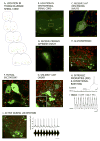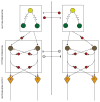Strategies for delineating spinal locomotor rhythm-generating networks and the possible role of Hb9 interneurones in rhythmogenesis
- PMID: 17905441
- PMCID: PMC5061561
- DOI: 10.1016/j.brainresrev.2007.06.025
Strategies for delineating spinal locomotor rhythm-generating networks and the possible role of Hb9 interneurones in rhythmogenesis
Abstract
Despite significant advances in our understanding of pattern generation in invertebrates and lower vertebrates, there have been barriers to the application of the principles learned to the definition of networks underlying mammalian locomotion. Major difficulties have arisen in identifying spinal interneurones in preparations which allow study of neuronal intrinsic properties and the role of identified interneurones in locomotor networks. Recent genetic technologies in which selective expression of fluorescent proteins in specific populations of mouse spinal neurones have provided new avenues of investigation. In this review, we focus on the generation of locomotor rhythm and outline criteria that rhythm-generating neurones might be expected to fulfill. We then examine the extent to which a recently identified population of spinal interneurones, Hb9 interneurones, fulfill these criteria. Finally, we suggest that Hb9 interneurones could be involved in an asymmetric model of locomotor rhythmogenesis through projections of electrotonically coupled rhythm-generating modules to flexor pattern formation half-centres. The principles learned from studying this population of interneurones have led to strategies to systematically evaluate neurones that may be involved in locomotor rhythmogenesis.
Figures




References
-
- Arber S, Han B, Mendelsohn M, Smith M, Jessell TM, Sockanathan S. Requirement for the homeobox gene Hb9 in the consolidation of motor neuron identity. Neuron. 1999;23:659–674. - PubMed
-
- Arshavsky YI, Deliagina TG, Orlovsky GN, Panchin YV, Popova LB, Sadreyev RI. Analysis of the central pattern generator for swimming in the mollusk Clione. Ann N Y Acad Sci. 1998;860:51–69. - PubMed
-
- Baev KV, Degtiarenko AM, Zavadskaia TV, Kostiuk PG. Activity of interneurons of the lumbar region of the spinal cord during fictive locomotion of thalamic cats. Neirofiziologiia. 1979;11:329–338. - PubMed
Publication types
MeSH terms
Grants and funding
LinkOut - more resources
Full Text Sources

